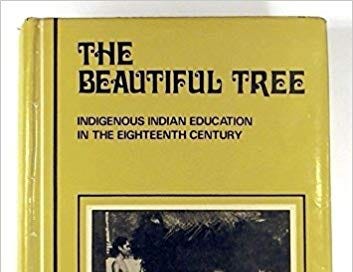The Beautiful Tree - Indian Indigenous Education In The 18th Century
My breakdown of the definitive book on Indian education before the British came
“The Beautiful Tree by Dharampal” seems to be cited by everyone about how it “crushes the narrative of low to no education in India before the British”, but I, like many, hadn’t read it. It seemed way too intimidating, with a 100-page introduction, and 400 pages of appendixes with original sources.
Thanks to popular demand, I gained the motivation to read it, and Gods, I’m so glad to have read it. It has changed literally everything about how I view our history, and it’s appalling how much of our thought process even in the present day has been force-fed to us by the British. Identifying the roots of these thoughts is the first step to changing how we think.
Not only do we see the roots of how we approach life and education, but the book paints us a vivid picture of how education used to be. The most surprising thing for me was that a schoolboy in 1750 would have 12 hours of school, from 6 am to 6 pm, for a decade of his life, and his parents needed to pay nothing for their child’s education, for it was funded by taxes well enough that every village had at least one school.
I analyzed this book in six parts, going deeper into the history and context, and trying to also provide present-day perspective.
The first article went into what British education was like in the 18th century, and how that would have affected how the British perceived Indian education. We also look into the background of the author Dharampal - how his Gandhian background led him to study this topic, and do the appropriate research.
The second article went into the Scottish Enlightenment and how that led to hordes of Scots coming to India as soldiers and officials of the East India Company and the British government. We see how the Scots were worried about the British destroying Indian culture just as they had destroyed Scottish Highland culture and clans, and were motivated to preserve Indian knowledge before it was destroyed. This was helped by the goals that administrators and missionaries had, of selectively picking Indian knowledge and culture to elevate so as to make Indians more British and more Christian.
The Beautiful Tree #2 - How The Scottish Enlightenment helped the documentation of India
This section has very interesting deep-dives and side-quests, I gotta say.
The third article went into the qualitative conclusions of the data gathered by British administrators in the 19th century, and painted a picture of what the Indian schoolboy studied and how big of a role school played in his life.
The Beautiful Tree #3 - Indian Education in the 18th Century
We’re reading Dharampal’s The Beautiful Tree - Indian Indigenous Education In The 18th Century. The past two weeks, we’ve covered a lot of context about education in England and India, as well as the motivations behind Britishers documenting India. This week, we’ll paint a vivid picture on what education in India was like in the 18th century.
The fourth part continues where the third ended, with analysis of district-wise data in Madras and Bengal, what women’s education was like, and a deep-dive into what higher education was like, giving me context on the ‘kashi yatra’ section of weddings in certain communities, because going to Kashi was literally going to get a PhD.
The Beautiful Tree #4 - Data, Girls' Education and College in 18th Century India
We’ve been reading the book The Beautiful Tree - Indian Indigenous Education In The 18th Century for the past four weeks, and going in detail about the information contained in it, and looking at historical context the book might not fully provide to understand it better.
The next part is a very important and intimidating section, which I’ve worked pretty hard to simplify. It’s about how education was funded, and what kinds of taxes were levied to fund education and art. We also study how the British changed the tax regime, leading to decay and collapse of not only education, but all Indian institutions that propagated culture and social security.
The Beautiful Tree #5 - How Indian Education Was Funded in the 18th Century
We’ve been reading the book The Beautiful Tree - Indian Indigenous Education In The 18th Century for the past five weeks. In the first article, we went into what British education was like in the 18th century. In the second, we explored how the Scottish Highland clearances led to the Scottish enlightenment, which then led to the field of Indology.
The last part goes into the prevalent thinking among the elite in Europe. They hated everything about Indian civilization and they hoped it would die so they could replace it with something more similar to what they had, while still being conducive to their vampirish resource extraction. Here is where Macaulay and Marx come in.
The Beautiful Tree #6 - The Thinkers Behind Dismantling Indigenous Education
Thank you for sticking with the me reading The Beautiful Tree - Indian Indigenous Education in The 18th Century for the past six weeks! I have enjoyed understanding and exploring the ideas in this excellent book, and I hope we all have become a little richer in our ideas from this series.









